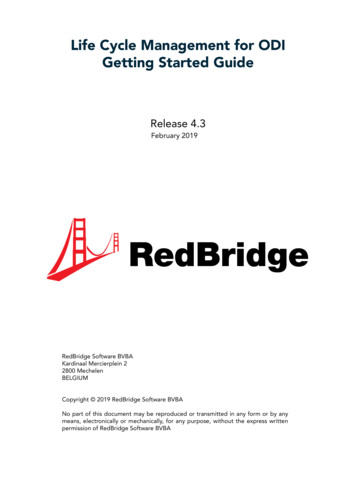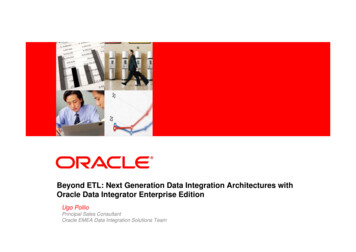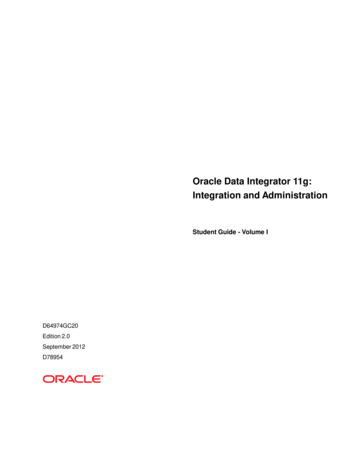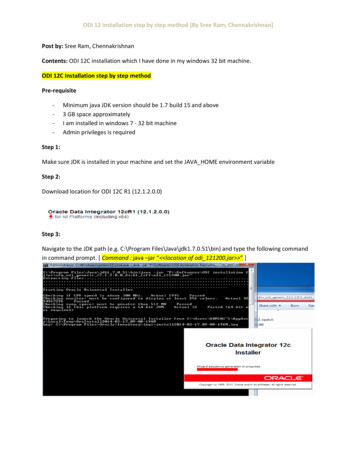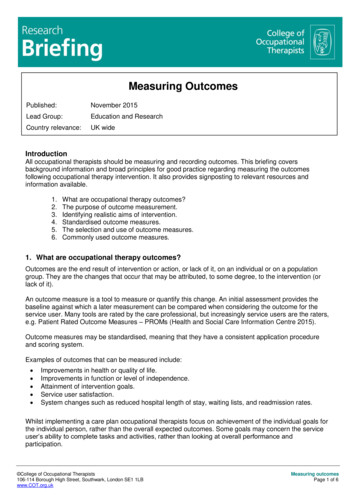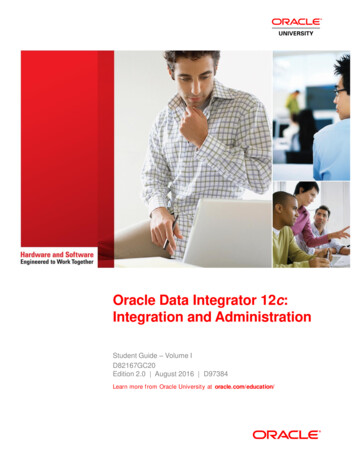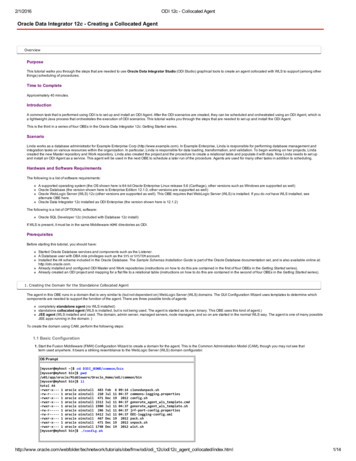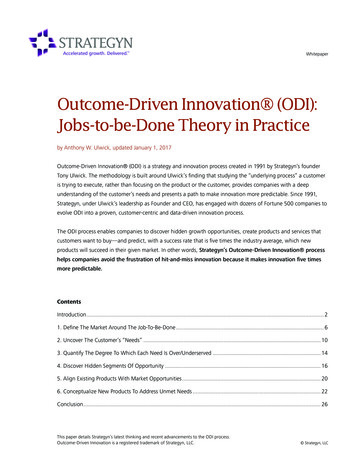
Transcription
Accelerated growth. Delivered. WhitepaperOutcome-Driven Innovation (ODI):Jobs-to-be-Done Theory in Practiceby Anthony W. Ulwick, updated January 1, 2017Outcome-Driven Innovation (ODI) is a strategy and innovation process created in 1991 by Strategyn’s founderTony Ulwick. The methodology is built around Ulwick’s finding that studying the “underlying process” a customeris trying to execute, rather than focusing on the product or the customer, provides companies with a deepunderstanding of the customer’s needs and presents a path to make innovation more predictable. Since 1991,Strategyn, under Ulwick’s leadership as Founder and CEO, has engaged with dozens of Fortune 500 companies toevolve ODI into a proven, customer-centric and data-driven innovation process.The ODI process enables companies to discover hidden growth opportunities, create products and services thatcustomers want to buy—and predict, with a success rate that is five times the industry average, which newproducts will succeed in their given market. In other words, Strategyn’s Outcome-Driven Innovation processhelps companies avoid the frustration of hit-and-miss innovation because it makes innovation five timesmore predictable.ContentsIntroduction . 21. Define The Market Around The Job-To-Be-Done . 62. Uncover The Customer’s “Needs” . 103. Quantify The Degree To Which Each Need Is Over/Underserved . 144. Discover Hidden Segments Of Opportunity . 165. Align Existing Products With Market Opportunities . 206. Conceptualize New Products To Address Unmet Needs . 22Conclusion . 26This paper details Strategyn’s latest thinking and recent advancements to the ODI process.Outcome-Driven Innovation is a registered trademark of Strategyn, LLC. Strategyn, LLC
IntroductionExecutives know that their company’s ability to innovate is the key to ongoing success. In order to address thischallenge, companies spend on R&D, create programs for open innovation, invest in innovation centers and bigdata, create customer advisory boards, and more—yet these investments alone have not helped to make success atinnovation significantly more predictable.For most companies, innovation remains a flawed business process, yielding failure rates that are consistently over 80percent. The question is: why? What is the root cause of this failure? With 25 years’ experience studying this problem,Strategyn can offer an explanation: While executives, managers and entrepreneurs agree that the goal of innovationis to create products and services that address unmet customer needs, companies struggle to predictably createwinning products because they fail to define their customers’ needs with the rigor, precision, and disciplinethat is required to discover, prioritize and capitalize on opportunities for growth.In most companies, managers do not agree on what a “need” even is. As a result, when it comes to innovation,marketing and development managers still struggle to reach agreement on what the customer’s needs are, which ofthose needs are unmet, and to what degree. They also struggle to discover segments of customers with unique setsof unmet needs.Despite the fact that companies have access to more customer data than ever before, they lack the informationneeded to effectively evaluate their ideas for new products. In other words, companies struggle to innovate becausethey have yet to develop the skills needed to define, prioritize and use the inputs that lead to predictable innovation.Without a system for evaluating which ideas are best, companies are forced to guess at which solutions will win inthe marketplace. Not surprisingly, they often guess wrong. Companies cope by adopting techniques for pivoting andfailing fast, which do little to help them make the right move to begin with. The problem with innovation is clear:without knowing precisely what you target you trying to hit, your chances of actually hitting it are slim. Thisproblem is universal.In 1991, Strategyn proposed a solution to this problem: to gain deep insight into the customer’s needs, companiesshould stop focusing on the product and the customer and instead aim to understand the “underlying process”(or job) the customer is trying to execute when they are using a product or service.Whitepaper: Outcome Outcome-Driven Innovation (ODI)2
IntroductionThe theory holds that to create a product or service thatcustomers will want, companies must first understandwhat fundamental measures of performance thosecustomers use to measure success when getting the“I call Anthony Ulwick the Deming ofinnovation because more than anyone else,he has turned innovation into a science.”job done. To obtain this understanding, Strategynsuggests that companies break down the customer’s-Philip Kotler, 2016underlying “job-to-be-done” into discrete process stepsand ascertain from them what must be measured and controlled to ensure the job is executed with the speed,predictability, and effectiveness they desire. Strategyn calls these uniquely constructed performance metrics thecustomers’ desired outcomes. They possess distinctive characteristics (measurable, controllable, stable over time,devoid of solutions, multi-purpose) that make them the perfect need statement and the perfect input into in theinnovation process.With insight into which of the customer’s 100 or more desired outcomes are underserved, companies are able tofocus their ideation efforts on specific targets and then evaluate their ideas against those same performancemetrics to determine if their ideas for new products will help the customer get the job done better. Knowingwhether or not a new product concept/idea will help the customer get the job done significantly better, in advance ofproduct development, is key to ensuring the predictability of the innovation process.Strategyn’s first application of this methodology was completed in a 1992 engagement with the medical devicecompany Cordis Corporation. The challenge: to reinvent Cordis’s line of angioplasty balloon products. Strategynled the effort to interview interventional cardiologists to break down and analyze the underlying process they wentthrough to “restore blood flow in a blocked artery.” The customer’s desired outcomes were revealed, prioritizedand addressed. By mid-1993, Cordis launched 19 new products, all of which became number 1 or 2 in the market.Cordis’ market share increased from 1 percent to more than 20 percent, and its stock price more thanquadrupled.Whitepaper: Outcome Outcome-Driven Innovation (ODI)3
IntroductionCordis is one of hundreds of successes that companies have achieved in the years since using this innovation process,which Strategyn calls Outcome-Driven Innovation (ODI). Six of these successes are described in detail in a bookrecently released, JOBS TO BE DONE: Theory to Practice (Ulwick, October 2016). The original book on the subject,What Customers Want, written in 2005, offers foundational insights into the ODI process and additional case studies.Strategyn introduced ODI to Harvard Business Schoolprofessor Clayton Christensen in 1999 (see the video).Christensen later popularized the theory in his book, TheInnovator’s Solution (2003), labeling it “jobs-to-be-done“Ulwick’s outcome-driven programs bringdiscipline and predictability to the oftenrandom process of innovation.”theory” and citing Strategyn and its practices. Today, wealso refer to the theory as “jobs-to-be-done theory” and-Clayton Christensen, 2005describe ODI as the process that puts the theory intopractice.What makes Outcome-Driven Innovation unique is that Strategyn been applying it in Fortune 500 companies for 25years and it has a proven track record. How good is it? An independent study conducted with Strategyn’s clients whoused it to introduce new products put their success rate at 86 percent. That is a five-fold improvement in the chancesfor success. Put another way, the study showed that ODI makes innovation 5-times more predictable.The ODI process is intuitive: if a company knows what target to hit, the chances of hitting it increasedramatically. For example, there is less than a one percent chance that a company will randomly conceptualizea solution that addresses all the unmet needs in a segment of the market if the company is unaware that thesegment exists and unaware of what the unmet needs are. But once the target is known, a winning product can beconceptualized—often within days or hours.Whitepaper: Outcome Outcome-Driven Innovation (ODI)4
IntroductionStrategyn has designed ODI from the start to transform innovation from an art into a science. The processis comprised of the six steps defined below. The ODI process incorporates unconventional qualitative andquantitative market research techniques that yield predictive data and a sophisticated market segmentationmethodology that helps companies discover and prioritize hidden market opportunities.ODI-based research explains how, specifically, a company should innovate to undermine the established leaders ormaintain a leadership position. Most importantly, the ODI process informs companies how to create productsand services that customers will want to buy—and predict which new products will succeed.Each step is explained in detail below.Whitepaper: Outcome Outcome-Driven Innovation (ODI)5
1. Define The Market Around The Job-To-Be-DoneCompanies often define the markets they serve around the technology in their product offerings—a technology thatone-day will become obsolete. Clearly, this approach is misdirected, but it’s one that has been repeated by hundredsof companies over the decades. Many companies today find themselves in this same situation.A market, which is the target of everything a company does, should not be defined around something so unstablethat it may only remain valid until the next product iteration. It should be defined around something that is stable fordecades, making long-term strategic investments more attractive and providing the company with a vision for thefuture. For this reason, ODI defines a market around the job-to-be-done.The first step in applying Jobs-to-be-Done Theory is to define the target market as “a group of people the jobthey are trying to get done.” Parents (a group of people) who are trying to pass on life lessons to their children (thejob-to-be-done) constitute a market. Dental hygienists who clean patients’ teeth and farmers who grow a crop alsoconstitute markets.Defining a market around the job-to-be-done has many benefits: It enables the transformation of innovation from art to science. Because the job-to-be-done is aprocess, statistical process control principles can be applied to help figure out what factors cause customersto struggle when getting the job done. Consequently, proven ODI-based qualitative and quantitative marketresearch techniques can be applied to discover customer needs, which are unmet, and which customersegments are under- and over-served. It provides a central focal point to define all customer needs. The core functional job is the stable, longterm focal point around which all other needs (related, emotional and consumption chain jobs, and financialoutcomes) are defined and around which value creation is centered. The job-to-be-done offers a startingpoint from which to understand the market from the customer’s perspective. It more accurately defines the competition. The job-to-be-done does not care if your company providesproduct, software, or service offerings. The job has no solution boundaries and no competitive boundaries.This means that a deep understanding of the job will inform the creation of a solution that transcends thetraditional competitive landscape. It acts as protection against disruption. A focus on the job-to-be-done keeps a company focused on itstrue mission over the long term—to help customers get a job done better. With an ongoing focus on thejob, a company is more likely to make investments in the right technologies and not miss key opportunities.In addition, they are less likely to get sidetracked by phantom opportunities or make investment decisionsthat will fail to get the job done better and/or more cheaply.Whitepaper: Outcome Outcome-Driven Innovation (ODI)6
1. Define The Market Around The Job-To-Be-Done It provides global insights into the market. The job-to-be-done has no geographical boundaries. Peoplewho live in the USA, France, UK, Germany, South Korea, China, Russia, Brazil and Australia have manyjobs in common that they are trying to get done. The solutions they use to get those jobs done may varydramatically from geography to geography, but the jobs are the same. The degree to which the customer’sdesired outcomes are underserved may also vary by geography, depending on the solutions they use, butthe collective set of desired outcomes are the same.Defining The Job To Be DoneDefining the core functional job-to-be-done correctly is a prerequisite to predictable success. Getting it wrongis a problem, but getting it right is not easy. Defining the job too narrowly will limit the discovery of growthopportunities. Defining the job too broadly will result in non-actionable insights.Strategyn has learned that most products only get part of a job done. The goal is to discover the entire job thecustomer is trying to accomplish. This is why it is incorrect to ask a customer, “What job did you hire my product todo?” or to ask yourself, “What is the job-to-be-done of my product?” as these questions may not reveal the entirejob. Questioning should not start with the product.For example, if a stovetop kettle maker were to ask its users “what job did you hire that product to do?”, it is likelythey would tell you they hired it to “boil water.” That may be correct, but boiling water is just a step in the job thecustomer is ultimately trying to get done—which, in our example, is “to prepare a hot beverage for consumption.”If the stovetop kettle maker defines the job too narrowly, then it is at risk of a competitor coming along (like Keurig)with a solution that gets the entire job done on a single platform.To avoid defining the job too narrowly, a company must understand how its product fits into what the customer istrying to accomplish. The question to ask is, “When you find yourself in the situation that you are using my product;what job are you ultimately trying to get done—what is the underlying task at hand?” Or, “what is the overall goalyou are trying to achieve?”Whitepaper: Outcome Outcome-Driven Innovation (ODI)7
1. Define The Market Around The Job-To-Be-DoneOn the other side of the spectrum, defining the job too broadly can make it difficult, if not impossible, for a companyto tackle a job in its entirety. To avoid this from happening, think about the company, its products and its capabilitiesand ask, “can and will the company address this job from beginning to end over time?” If the company does nothave or is not willing to acquire the capabilities, resources, funding, technology, and talent to tackle the broader jobthen the job is defined too broadly from a practical standpoint.To define the core functional job-to-be-done at the right level of abstraction, guidelines are outlined in the mostrecent book on ODI, JOBS TO BE DONE: Theory to Practice. When engaged in market discovery (trying to definealtogether new markets to pursue through a jobs-to-be-done lens) we recommend using the template in Figure 1.Figure 1: The Jobs-to-be-Done Market Discovery TemplateTMDefine the Core Functional JTBDWhen trying to.In this situation.Verb Object Contextual ClarifierDefine OutcomesDefine Emotional JobsPeople struggle to .And want to feel and beperceived as.Ask: What makes getting thisjob done in this situation timeconsuming, inefficient, unpredictable,inconvenient or difficult?Ask: When getting this job done,how do you want to be perceived byothers and how do you want to feelor avoid feeling?Ask: What are you trying to accomplish? What underlying process are you tryingto execute?The Jobs-to-be-Done MarketDiscovery Template is a frameworkthat entrepreneurs, startups andmanagers can use to organize a set ofmultidimensional and complex needstatements in a way that effectivelydescribes a target market.To create a product or service thataddresses unmet customer needs,there must first be agreement onwhat a need is, what the needs are,which are unmet and if there is asegment of customers with a uniqueset of unmet needs.This template offers a qualitativeapproach to addressing each of thesequestions in a story format.The Job MapWith the core functional job defined, the next step in the ODI process is to create a “job map” for that job. Ajob map is a visual depiction of the core functional job, deconstructed into its discrete process or job steps, whichexplains step-by-step exactly what the customer is trying to get done. A job map does not show what the customer isdoing (a solution view); rather, it describes what the customer is trying to get done (a needs view).Analysis of hundreds of jobs has revealed that all jobs consist of some or all of the eight fundamental process steps:define, locate, prepare, confirm, execute, monitor, modify and conclude (see the universal job map in Figure 2.)Whitepaper: Outcome Outcome-Driven Innovation (ODI)8
1. Define The Market Around The Job-To-Be-DoneFigure 2: The Universal Job MapCore Functional OrganizeVerifyExecuteMonitorModifyConcludeA job map is not a customer journey or customer experience map: it does not describe the journey the customergoes through to buy, receive, set-up, use, upgrade, clean and maintain a product. These activities are consumptionchain jobs that are captured and treated separately. If you are focusing on the purchase process or the customerexperience, you are not focused on the core functional job.A good job map will describe what the customer is trying to get done independent of the solution they are using. Sowhether customers are in the USA, China or Germany, or whether they are using one of ten competing products, asingle job map will describe what each and every customer is trying to get done. A completed job map represents the“ideal process flow” for that job: all the steps in the ideal order for efficient execution.The job map is created in order to: Define vision and direction. The completed job map lays out the long-term strategy and vision for theorganization—which is to devise a solution that gets the entire job done on a single platform or with asingle offering (which may include hardware, software and services). Discover opportunities. It is often the case that competitive insights and innovative ideas can come fromanalyzing the job map, as it points out holes and deficiencies in existing solutions. Guide customer needs gathering. From a tactical standpoint, the job map serves as a framework anda guide for capturing the customer’s desired outcomes. For this reason, the job map is created beforeattempting to capture desired outcome statements.To learn more about job-mapping, see “The Customer-Centered Innovation Map” (Ulwick and Bettencourt) includedby the Harvard Business Review in its book on the top 10 innovation articles.Whitepaper: Outcome Outcome-Driven Innovation (ODI)9
2. Uncover The Customer’s “Needs”Many companies believe that it is impossible to know all its customer’s needs and that this knowledge is simplyunattainable. ODI proves that this is not the case, but there is a common myth that feeds the misconception. Themyth is the notion that “customers don’t know what they want,” implying that customers do not know their“needs” and therefore are incapable of articulating the information that a company needs to win at innovation.It is often argued, for example, that, “A customer would have never asked for the microwave oven.” That is true, butthe microwave oven is not a need—it is a solution. While customers may not know what solutions they want, theymost certainly know their needs related to getting a job done. In this case, they know they want to prepare a meal(the job-to-be-done) that is not overcooked or undercooked, and they want to do it more quickly without having toclean up. The problem isn’t that customers don’t know their needs. The problem is that there is confusion andlack of agreement as to what a “need” even is.Companies now have endless amounts of customer data at their disposal. What must they do to extract thecustomer inputs that are needed to make innovation more predictable? Strategyn’s Outcome-Driven Innovationprocess offers a solution. The Jobs-to-be-Done Needs Framework (see Figure 3) provides a model for (i)categorizing, defining, capturing, and organizing all your customers’ needs.This framework introduces the types of customer needs that must be considered to gain a deep understanding ofwhat a customer is trying to accomplish. They include (i) the core functional job-to-be-done, (ii) consumption chainjobs, (iii) the desired outcomes tied to the core functional and consumption chain jobs, (iv) related jobs, (v) emotionaland social jobs, and (vi) the buyer’s financial desired outcomes. For a given market, all needs are defined and centeredaround the customer’s core functional job-to-be-done.Whitepaper: Outcome Outcome-Driven Innovation (ODI)10
The Jobs-to-be-Done Needs Framework provides companies with a common language around which to definecustomer needs. It takes a multilayered and complex set of inputs and shows how they should be categorized andorganized, why they are captured, and how they should be used. The framework brings order to a historically chaoticpractice. Knowing exactly what is meant by “need” and knowing what “needs” exist in a market changes everything.Figure 3: The Jobs-to-be-Done Needs Framework4. ConfirmOutcome 31Outcome 32 Outcome n5. ExecuteOutcome 41Outcome 42 Outcome n6. MonitorOutcome 51Outcome 52 Outcome n3. PrepareOutcome 21Outcome 22 Outcome n7. ModifyOutcome 61Outcome 62 Outcome nCore Functional Job2. LocateOutcome 11Outcome 12 Outcome n8. ConcludeOutcome 71Outcome 72 Outcome nJob Executor1. DefineOutcome 1Outcome 2 Outcome nJob 1Job 2Job 3 Job nRelatedJobs†Outcome 1Outcome 2Outcome 3Outcome 4Outcome 5 Outcome DoneNeeds FrameworkJob 1Job 2Job 3 Job nEmotionalJobs*Product LifecycleSupport TeamDisposeOutcome nPurchaseOutcome 1ConsumptionChain JobsReceiveRepairInstallUpgradeto useMaintainInterfacewithStoreCleanLearnto useSetupTransport*Includes the Job Executor, a third-party completing any of the consumption chain jobs, and the company selling the product/service.†Can be the Job Executor or another individual.Whitepaper: Outcome Outcome-Driven Innovation (ODI)11
2. Uncover The Customer’s “Needs”The Desired Outcome StatementStrategyn has spent over two decades working to “invent” the perfect customer need statement. We have concludedthat a perfect need statement will clearly describe a customer’s measure of success associated with getting the jobdone. For any given job, customers have many measures of success, often 100 or more. Each one of these speciallyconstructed statements, or “desired outcomes,” describe how it is possible to get the job done better along a specificdimension: such as speed, predictability, efficiency, output, throughput or waste. We define desired outcomesas customer-defined performance metrics that are tied to the job-to-be-done making value creationmeasurable, controllable and predictable.Desired outcome statements are powerful and valuable because they are designed to have a very unique set ofcharacteristics. In a single statement, a desired outcome defines how a customer is measuring value and what acompany must control in the design of the solution to satisfy it. The same exact statement that comes from thecustomer can be used by the entire organization as a focal point around which to create and communicate customervalue along that dimension. In addition to being measureable, controllable and actionable, desired outcomestatements are purposely designed and structured to be devoid of solutions and stable over time, thus making themuseful customer inputs for years to come. Lastly, they can be quantified for importance and satisfaction, making itpossible to determine which outcomes are under- and overserved.We have defined desired outcome statements to possess these characteristics for one very important reason: definedin this manner, we are able to determine which customer needs (outcomes) are unmet and predict—inadvance of product development—just what solutions/ideas are most likely to get the job done better andwin in the marketplace. This is why we often refer to prioritized desired outcome statements as “predictive data”.Desired-outcome statements (shown in their hierarchy in Figure 4) also have a specific structure and syntax, whichis necessary because differences in structure, terminology, and syntax from statement to statement can introduceunwanted sources of variability that alter the importance and satisfaction ratings customers give the statements. Thisin turn affects the way customers end up prioritizing which outcomes are most underserved.Whitepaper: Outcome Outcome-Driven Innovation (ODI)12
2. Uncover The Customer’s “Needs”A desired outcome statement includes a direction of improvement, a performance metric (usually time or likelihood),an object of control (the outcome), and a contextual clarifier (describing the context in which the outcome is desired).When creating a desired outcome statement, we use the following structure:Direction of improvement Performance metric Object of control Contextual clarifierFor example, when trying to listen to music, a listener may want to “minimize the time it takes to get the songs in thedesired order for listening”, or “minimize the likelihood that the music sounds distorted at high volume”. This levelof granularity in defining a need is critical to establishing a valuable input into the innovation process.Desired outcome statements are uncovered through literature searches and through interviewing methods such aspersonal and group interviews, and observational and ethnographic research. While most qualitative research hasa short shelf life, a complete set of desired outcome statements is an important company asset for years to comeas desired outcomes don’t change over time—the solutions that address them do. Learn more about desiredoutcomes and job statements in the article Giving Customers a Fair Hearing (Ulwick) published in the Spring 2008 MITSloan Management Review.Figure 4: The Desired Outcome Statement - Needs HierarchyJob-to-be-doneJob Step 1OutcomeOutcomeOutcomeOutcomeJob Step 2Job Step 3OutcomeOutcomeOutcomeOutcomeOutcomeWhitepaper: Outcome Outcome-Driven Innovation (ODI)OutcomeOutcomeOutcomeOutcomeJob Step Job Step OutcomeOutcomeJob Step 6OutcomeOutcomeOutcome13
3. Quantify The Degree To Which Each NeedIs Over/UnderservedWhile understanding all the customers’ desired outcomes ensures the ODI process is customer-centric, quantifyingthem ensures the process is data-driven. With a complete set of desired outcome and job statements in hand, acompany is able to obtain quantitative insights into its market that were never before possible.The quantitative research methods we have created as part of the ODI process are unique, challenge conventionalwisdom, and are designed to achieve the following goals: Discover opportunities to get the job done better (underserved outcomes). Once there is agreement ina company as to what a “need” is and what all the customer needs are, the next step is to gain agreementon which needs are unmet. A need is unmet if it is important to the target population, but not satisfied bythe solutions customers are using today. Once these underserved outcomes are revealed, a company knowsalong what dimensions is has to get the job done better. Discover opportunities to get the job done more cheaply (overserved outcomes). A need is overservedif it is unimportant to the customer, yet very satisfied by the solutions customers are using today. Once theseoverserved outcomes are revealed, a company knows along what dimensions to focus to get the job donemore cheaply. Quantify the degree to which each outcome in over/underserved. The biggest opportunities for gettingthe job done better and/or more cheaply are prioritized once the degree to which each outcome is overor underserved is known. Using the importance and satisfaction data obtained for each outcome, ouropportunity algorithm is used to calculate an opportunity score for each outcome, revealing their priorityorder. Determine the strengths and weaknesses of competing solutions. Customers that use differentsolutions rate the outcomes for satisfaction, revealing how well competing solutions address each of theoutcomes. This approach results in a detailed competitive analysis that shows where each competi
recently released, JOBS TO BE DONE: Theory to Practice (Ulwick, October 2016). The original book on the subject, What Customers Want, written in 2005, offers foundational insights into the ODI process and additional case studies. Strategyn introduced ODI to Harvard Business Scho
